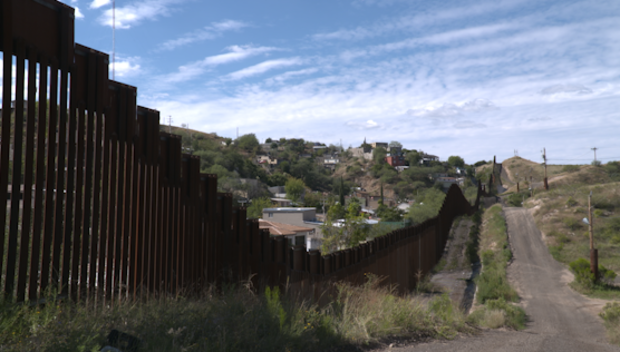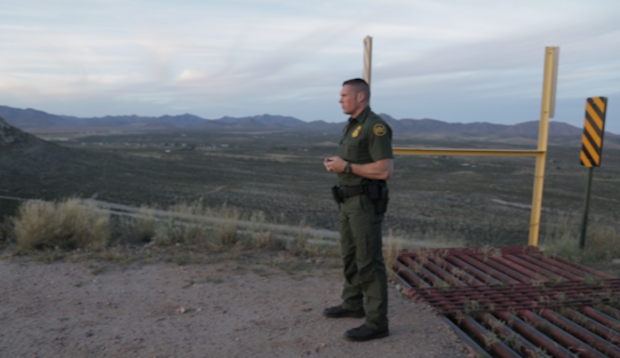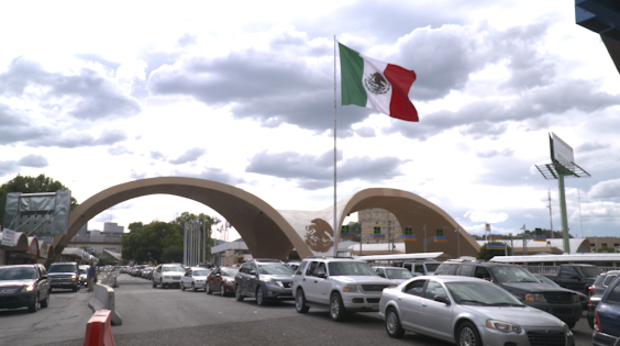U.S. border officer: "Do you think a wall is gonna stop them?"
The temperature dropped drastically as nightfall cloaked Arizona’s 100,000-square-mile desert, including sections on the border with Mexico, surrounding the small city of Douglas.
Matthew Eisenhauer, a border patrol agent with the Tucson sector, steered his white Chevy Tahoe off the highway onto a dirt road, parked, and stepped out into brush-covered terrain near the border.
“We had a sensor activation. Two individuals... made an incursion into the U.S.,” said Eisenhauer, setting out on foot without a flashlight, in the dark, to join fellow border patrol agents already stationed there in an effort to apprehend the suspects. According to Customs and Border Patrol -- America’s largest law enforcement agency, with an annual budget of $10.7 billion that has increased by 75 percent over the past decade -- more than 1,100 individuals are apprehended along the border every day.
As well as individual attempts to cross into the U.S. illegally, some are suspected of crimes including drug smuggling and human trafficking. Illegal immigration happens routinely, as do apprehensions along unfenced sections of the U.S.-Mexico border.
According to latest statistics, the Border Patrol reported 337,117 apprehensions nationwide in 2015, compared to 486,651 in 2014. The number of apprehensions has dropped dramatically since the year 2000, when a record high of 1.6 million people were caught trying to cross illegally.
In March 2016, the Border Patrol issued a “snapshot” of a given day; it said an average of 924 apprehensions between U.S. ports of entry occur daily, as well as 367 refusals of inadmissible persons.
A weakened U.S. economy after the 2008 recession, combined with tougher border security, has changed the landscape of illegal immigration. A recent Pew Research Center report found there are more immigrants from Mexico leaving the U.S. than coming in. From 2009 to 2014, one million Mexican immigrants and their families left the U.S. to return to Mexico, while an estimated 870,000 entered the U.S.
Of the 262-mile stretch of border that Eisenhauer oversees, 50 miles does not have a fence or wall.
“What we see is, to avoid detection, these criminal networks will try and exploit areas that are more remote... kind of a harsher terrain, with the idea that agents have less of a response time and less of response capabilities there and that there is less tactical infrastructure in those areas,” Eisenhauer told CBS News.
The idea of walling off America’s border with Mexico has become the focus of the immigration debate in the 2016 presidential campaign.
Republican nominee Donald Trump has for months argued that a wall would cut off the flow of illegal immigration into America. In controversial remarks last year, Trump referred to Mexican immigrants as “rapists” and claimed that the Mexican government was actively sending criminals to the United States. He has insisted that as president he would make Mexico pay for the wall he wants to build along the border.
But some border patrol agents like Eisenhauer, who typically work in remote areas, see it differently. Eisenhauer told CBS News that a “great wall” is not really the solution.
“Border fortification means a lot of things in different areas,” said Eisenhauer. “In areas where we can’t have a physical structure, we use the environmental challenges to funnel traffic into certain areas to identify and apprehend [individuals] in a more effective manner.”
That could involve “using ground sensors, using infrared or camera technology, [or] having agents there,” he said.
Eisenhauer declined to comment on “policy or legislation,” but maintained that the solution to border security requires a combination of technology, infrastructure and agents.
Outside of the border city of Douglas, Arizona, cameras can be found along the border, spaced out from one to four miles apart. Officers stationed in the Tuscon headquarters of this 262-mile border sector monitor the activity. They also oversee the six ports of entry in that area.
“The law is very clear that you must report to a CBP [Customs and Border Protection] officer before you come to the United States,” said Joe Agosttini, the assistant port director in Nogales for U.S. Customs and Border Protection, which daily processes about 29,000 people crossing between the two countries.
“You can see the officer, how detailed how he or she is when you come into the port of entry -- admissibility is number one,” said Agosttini, and gestured to an agent performing a vehicular check of an incoming white car: opening the trunk, inspecting the interior as well as underneath the car.
President Obama has said that the border has never been more secure. Customs and Border Protection operates at 328 ports throughout the nation, and since 2001, the number of border patrol agents has nearly doubled to more than 18,000 today.
Asked whether these measures have resulted in a drop in illegal immigration, Agosttini noted that someone still crosses the border illegally every five to ten minutes.
“Remember something, where there’s money, there’s gonna be customers, there’s always gonna be people trying,” he said. For some criminal networks on the south side of the Mexican border, both human trafficking and drug smuggling remain a lucrative businesses.
For agents like Agosttini, the question of how high a wall is, is almost irrelevant.
“Do you think a wall is gonna stop them from coming in? The fact that you have a house, would that stop a burglar from coming in?” said Agosttini. “I used to live about 30 feet from the fence, OK? I’ve been seeing these things for 30 years.”
Later that afternoon, a short drive from the port of entry, dozens of people walked along the 26-foot-high fence on the Mexican side of the Nogales border. Some even shouted over to their friends who had crossed to the American side to shop or visit family.
“What are they going to do, build a wall... that not even a helicopter could fly over?” Jose Luis, a resident in Nogales, Mexico, told CBS News through the fence. Referring to Donald Trump, he added, “He’s crazy!”
“Those who have a need to get across, they’ll find a way.... Even if they have to use catapults to fling themselves over, they’ll find a way, you know?”





